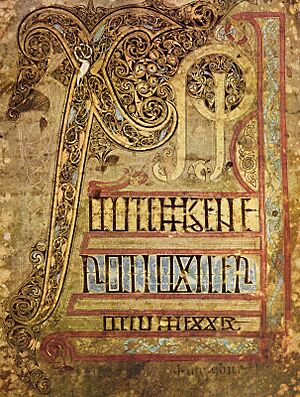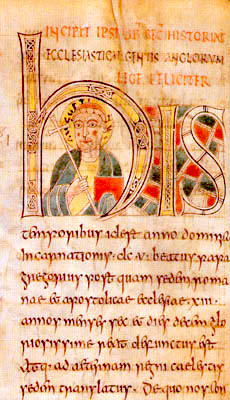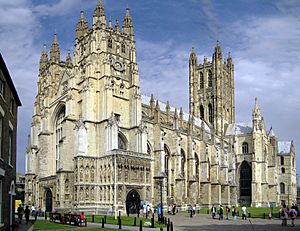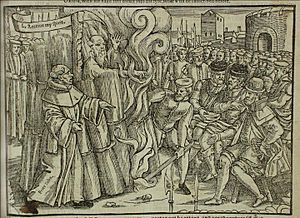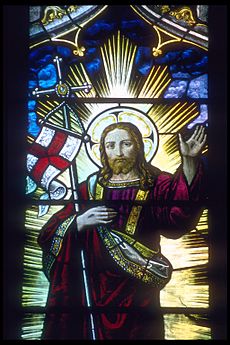History of Christianity in Britain facts for kids
The history of Christianity in Britain tells the story of Christian beliefs and churches in Britain from ancient times until today.
For many centuries, the Catholic Church was the main Christian church in Britain. This was from the 500s until the time of the Reformation in the Middle Ages. In 1534, the Church of England became the official church in England and Wales. It became independent from the Pope during the English Reformation. Later, in 1920, the Church in Wales became independent from the Church of England. In Scotland, the Church of Scotland was set up during the Scottish Reformation. It is recognized as the national church, but it is not officially established by the government.
After the Reformation, some people in Britain remained Catholic, especially in northern England. From the mid-1600s, other Protestant groups grew. These groups, called Nonconformists, included Congregationalists, Baptists, Quakers, and later, Methodists. They were separate from the official Church of England.
Christianity in England
Early Christianity
It's hard to know exactly when Christianity first came to Britain. Old stories about kings or apostles bringing Christianity have been shown to be untrue. The first real evidence of Christian communities, with churches and bishops, comes from the 200s and 300s.
At first, there weren't many Christians. For example, British bishops at a meeting in 353 had to ask for money to get home. By the end of the Roman period, many people in Britain were Christian. However, when the Saxons invaded, they brought their own gods. This led to a decline in the formal Christian church in many areas.
Anglo-Saxon Times
Christianity was largely brought back to Britain around 600 AD by St. Augustine. He set up his main church in Canterbury. He didn't manage to unite with the existing Welsh church. However, his mission, helped by missionaries from Scotland like Aidan and Cuthbert, was successful in Kent and then Northumbria.
The English church still has two main leaders, based in Canterbury and York. Early English Christian writings include the beautiful Lindisfarne Gospels and the historical books by the Venerable Bede. Over time, the Irish, Scots, and Welsh churches also adopted the Roman Christian practices.
Norman Influence
By the 1000s, the Normans had taken over England and started to conquer Wales. They brought changes to the church. For example, St. Osmund, a bishop, created the Sarum Rite, a special way of conducting church services.
Important church positions could be held by powerful people who might not even do the job themselves. This led to arguments, like the "Investiture Crisis." This was a fight over who should choose important church leaders. King John refused to accept the Pope's choice for archbishop of Canterbury. The Pope then banned church services in England and even kicked King John out of the church. King John eventually gave in.
A big reform movement in the 1300s was called Lollardy, led by John Wycliffe. He translated the Bible into English so more people could read it. After he died, his body was dug up and burned because his ideas were seen as wrong by the church.
Even before the Norman Conquest, Edward the Confessor built Westminster Abbey in a Romanesque style. Norman churches often had a square tower in the middle, which is still common in English churches. Many early cathedrals were built, like York Minster and Durham Cathedral. After a fire at Canterbury Cathedral in 1174, the Gothic style of architecture was introduced. The famous universities of Oxford and Cambridge started as religious schools.
The English Reformation
King Henry VIII was first called "Defender of the Faith" because he opposed Martin Luther's Protestant ideas. However, his wife couldn't have a son who lived, and the Pope wouldn't let him get a divorce. This led Henry to break away from the Pope.
In 1534, laws were passed that made the King, not the Pope, the head of the Church of England. It became treason to disagree with these changes. Many people, like Thomas More, were killed for staying loyal to the Catholic Church. The King also closed down monasteries and sold their lands. This made many powerful people support the new church.
Religious uprisings, like the Pilgrimage of Grace, were quickly put down. At first, the new Church of England didn't change much in its beliefs, except for who was in charge. Henry also had the Bible translated into English, which became the Great Bible. During this time, Wales was fully joined with England.
After Henry, religious policy changed with each ruler. His son, Edward VI, made the church more Protestant. His sister, Mary I, brought Catholicism back. But after her, Elizabeth I restored the Protestant Church of England with the Elizabethan Religious Settlement.
Later, James I supported the Anglican bishops and had the King James Bible created. However, plots against him led to stricter rules for Catholics. His son, Charles I, caused wars in Scotland and then the English Civil War. After the Civil War, the church was changed again. When the monarchy was restored, strict laws were made against non-Anglicans.
From 1689 to 1945
The religious rules set in 1689 lasted for a long time. The Church of England was very powerful. It stopped people who weren't part of it from holding important jobs in government, business, and universities. However, over time, rules against Nonconformists were slowly eased. The Toleration Act of 1689 allowed nonconformists to have their own chapels and preachers.
Anti-Catholicism
Strict laws against Catholics remained for a while, but they were rarely enforced. These laws were gradually removed, and by 1829, Catholics gained more rights. This was known as Catholic emancipation.
Evangelical Movement
A strong "Evangelical" movement grew inside and outside the Church of England in the late 1700s and early 1800s. John Wesley and his followers preached a lively religion. They encouraged people to have a personal connection with Jesus through reading the Bible and prayer. Wesley always stayed within the Church of England, but after he died, his followers formed the Methodist Church.
The Church of England also had its own evangelical group, called the "Low Church." They focused on saving souls and improving society. They worked to end slavery, stop dueling, and protect children and animals.
1851 Census
In 1851, the government counted how many people attended religious services in England and Wales. Out of 17.9 million people, about 10.9 million attended church. Most attended Church of England services, but many also went to other Protestant churches. A smaller number attended Catholic services.
Missionary Work
In the 1700s, Anglican and Methodist missionaries were active in the American colonies. After America became independent, British officials focused on strengthening the Church of England in other colonies, especially Canada.
In the 1800s, many missionary societies, like the London Missionary Society, worked across the British Empire. They were very active in Africa. Missionaries often provided education and medical help. They also promoted better hygiene and public health. Many were trained as doctors.
1900-1945
In the 1900s, there were new movements in the church, like the "Liturgical" and "Ecumenical" movements. Some church leaders, like Bishop Ernest Barnes, had modern ideas. He questioned some traditional Christian beliefs, which caused controversy.
Since 1945
Today, discussions in the church include whether women can be ordained as priests and the acceptance of homosexuality. While the Church of England has many baptized members, the Catholic Church in England and Wales now has more people attending weekly services, partly due to immigration.
Secularization
After World War II, Britain was seen as a Christian nation. However, over time, fewer people attended church. By the 1990s, Protestant churches had much smaller numbers. Compared to other Western European countries, Britain has lower church attendance and more people who say they have "no religion." The number of churches and clergy in the Church of England has also declined since 1970.
Christianity in Scotland
Scottish Reformation
In the 1500s, Scotland had its own Protestant Reformation. This led to the creation of the Church of Scotland, which became a Presbyterian church. This meant that bishops had less power. The ideas of Martin Luther and John Calvin influenced Scotland.
Early Protestant preachers, like Patrick Hamilton and George Wishart, were executed for their beliefs. Wishart's supporters then killed Cardinal Beaton and took over St. Andrews Castle. Survivors, including John Knox, were forced to be galley slaves in France. This made people angry at the French and created heroes for the Protestant cause.
In 1560, the Scottish Parliament adopted a new statement of faith, rejecting the Pope's authority. John Knox, who had been a follower of Calvin, became the most important leader. The new church adopted a Presbyterian system, which meant local leaders had more power. There was also a lot of iconoclasm, where religious images and statues were destroyed.
Even though most people were probably still Catholic at this time, the new church slowly converted people. Compared to other reformations, this one had relatively little persecution.
1700s in Scotland
In the 1690s, the Presbyterian church removed Episcopalians and heretics. Blasphemy even became a crime punishable by death. This extreme approach led to a reaction called the "Moderate" movement, which promoted more liberal thinking.
The 1700s saw the Church of Scotland start to split. Arguments over church leadership led to divisions between strict Evangelicals and more tolerant Moderates. The Patronage Act of 1712 allowed local landlords to choose ministers, not the church members. This caused some Evangelicals to leave the main church, forming new groups like the Secession Church in 1733. These new churches grew during the "Evangelical Revival."
In the Highlands and Islands, people held onto older Christian beliefs mixed with folk traditions. It was hard for the established church to reach these remote areas. Catholicism was mostly found in these Gaelic-speaking areas. Episcopalianism also existed, but its supporters faced difficulties after supporting rebellions.
1800s in Scotland
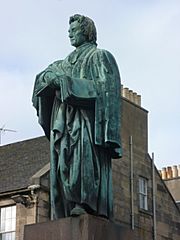
After many years of disagreement, the Evangelicals gained control of the Church of Scotland in 1834. They passed a law allowing church members to reject unwanted ministers. This led to a major split in 1843, known as the Disruption of 1843. About a third of the clergy left to form the Free Church of Scotland.
The Free Churches, which were more open to Gaelic language and culture, grew quickly in the Highlands. Thomas Chalmers led the breakaway group. He believed in small, equal communities based around the church. His ideas also influenced the main Presbyterian churches.
In the late 1800s, there were debates between strict Calvinists and those who didn't take the Bible literally. This caused another split in the Free Church. However, there were also moves to reunite churches. Different secessionist churches joined together, eventually forming the United Free Church of Scotland in 1900. In 1929, most of the Free Church rejoined the Church of Scotland.
Catholic emancipation in 1829 and many Irish immigrants, especially after the famine in the 1840s, helped Catholicism grow in Scotland. In 1878, a Catholic church structure was restored. Episcopalianism also revived, becoming the Episcopal Church in Scotland. Other churches like Baptists, Congregationalists, and Methodists also grew in the 1800s. The Salvation Army also arrived, working in the growing cities.
20th and 21st Centuries in Scotland
In the 1900s, new Christian groups like the Brethren and Pentecostal churches appeared. After World War II, church attendance generally declined for most denominations, leading to church closures. Talks about merging the main Presbyterian, Episcopal, and Methodist churches in Scotland ended in 2003 without an agreement.
Immigration has also changed the religious landscape. In the 2001 census, 42.4% of people in Scotland identified with the Church of Scotland, 15.9% with Catholicism, and 6.8% with other Christian groups. About 27.5% said they had no religion. More recent studies suggest that the number of non-religious people might be even higher.
Christianity in Wales
Welsh Reformation
Bishops Richard Davies and John Penry brought Calvinist ideas to Wales. These ideas developed through the Puritan period and the Welsh Methodist movement.
In 1567, Davies and others completed the first modern translation of the New Testament and the Book of Common Prayer into Welsh. In 1588, William Morgan translated the entire Bible into Welsh. These translations were very important for the survival of the Welsh language. They made Welsh a respected language for worship and everyday communication.
Nonconformity in Wales
Nonconformity was very important in Wales from the 1700s to the 1900s. The Welsh Methodist revival in the 1700s was a major religious and social movement. It started within the Church of England in Wales. However, Welsh Methodism was Calvinist, unlike the Arminian Methodism in England.
Welsh Methodists slowly built their own chapels and structures. This led to them formally separating from the Church of England in 1811 and forming the Presbyterian church of Wales in 1823.
The Welsh Methodist revival also influenced older nonconformist churches, like the Baptists and Congregationalists. They also grew and became stronger. As a result, by the mid-1800s, Wales was mainly a nonconformist country.
The 1904-1905 Welsh Revival was the biggest Christian revival in Wales in the 1900s. It's believed that at least 100,000 people became Christians during this time. However, it didn't stop the overall decline of Christianity in Wales, only slowing it down a little.
Images for kids
-
Statue of Methodism's founder John Wesley in St Paul's Churchyard
-
Howell Harris was one of the main leaders of the Welsh Methodist revival in the 18th century.


